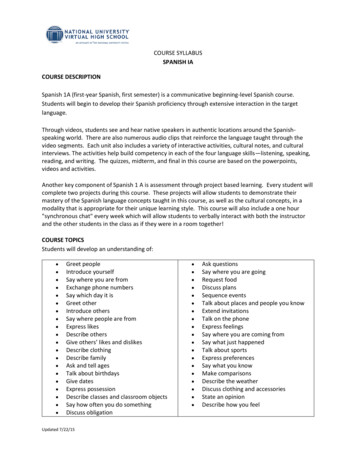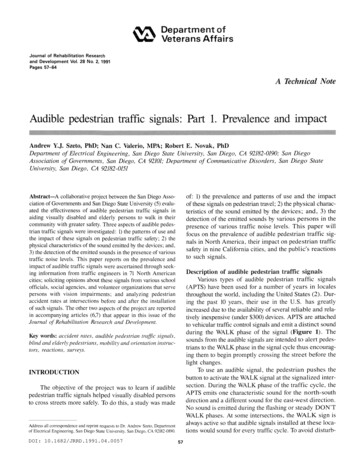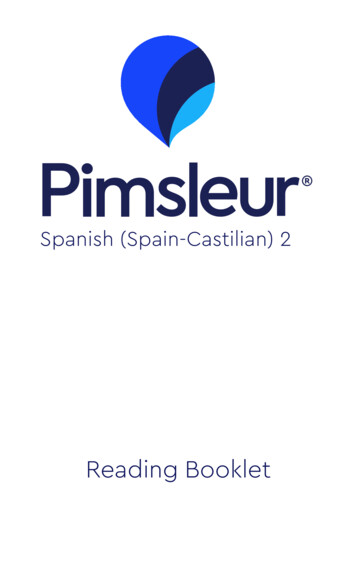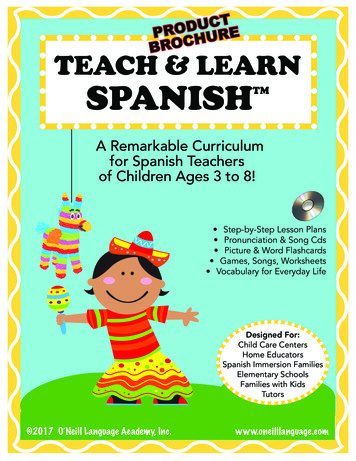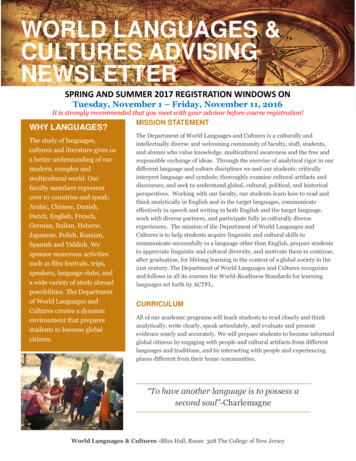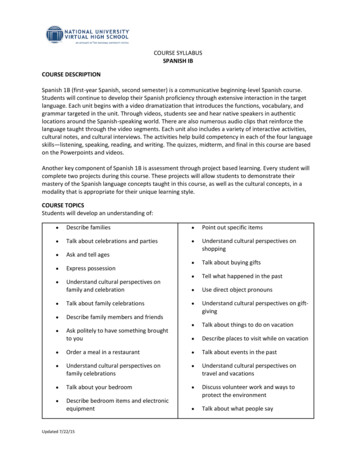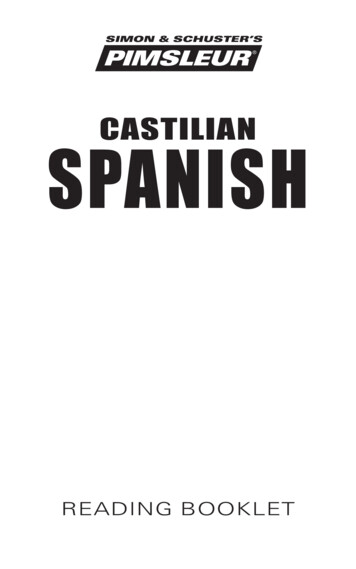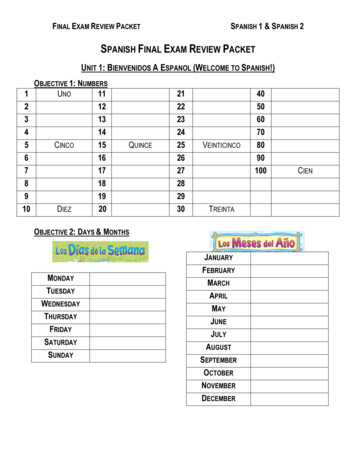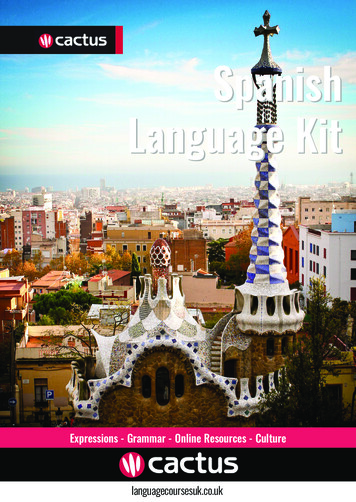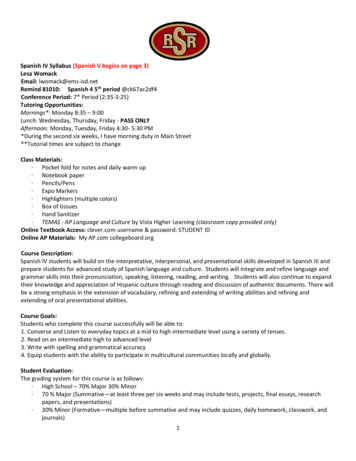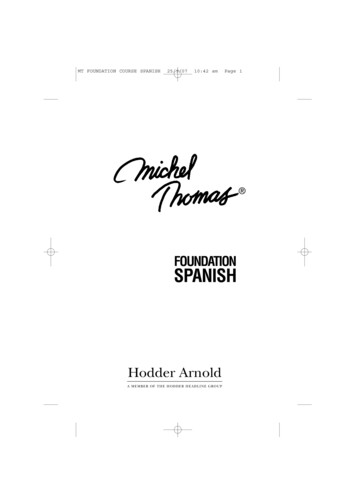
Transcription
MT FOUNDATION COURSE SPANISH25/9/0710:42 amPage i FOUNDATIONSPANISHHodder ArnoldA MEMBER OF THE HODDER HEADLINE GROUP
MT FOUNDATION COURSE SPANISH25/9/0710:42 amPage iiMichel Thomas, 1914–2005Michel Thomas, the internationally renownedlinguist and language teacher, who was recentlyawarded the Silver Star by the US Army for his braveryin the Second World War, died of heart failure at hishome in New York on 8th January. He was 90.To find out more, please get in touch with usFor general enquiries and for information on Michel Thomas:Call: 020 7873 6400 Fax: 020 7873 6325Email: michelthomas-enquiries@hodder.co.ukTo place an order:Call: 01235 400414 Fax: 01235 400454 Email: uk.orders@bookpoint.co.ukwww.michelthomas.co.ukYou can write to us at:Hodder Arnold, 338 Euston Road, London NW1 3BHVisit our forum at:www.michelthomas.co.ukUnauthorized copying of this booklet or the accompanying audio material isprohibited, and may amount to a criminal offence punishable by a fine and/orimprisonment.First published in UK 2000 by Hodder Headline, an Hachette Livre UK Company, 338 Euston Road, London NW1 3BH.Copyright 2000, 2006 Thomas Keymaster Languages LLC All rights reserved.All rights reserved. No part of this publication may be reproduced or transmitted in any form or by any means,electronic or mechanical, including photocopy, recording, or any information storage and retrieval system, withoutpermission in writing from the publisher or under licence from the Copyright Licensing Agency Limited. Furtherdetails of such licences (for reprographic reproduction) may be obtained from the Copyright Licensing AgencyLimited, Saffron House, 6–10 Kirby Street, London EC1N 8TS, UK.Typeset by Transet Limited, Coventry, England.Printed in Great BritainImpression10 9 8 7 6 5Year2010 2009 2008 2007ISBNs978 0 340 93893 5, 978 0 340 93896 6
MT FOUNDATION COURSE SPANISH25/9/0710:42 amPage 1IntroductionAnyone can learn alanguage withMichel Thomas!No books, no pens, nohomework, no memorizing –just sit back and let the mostsought-after language teacher inthe world be your guide. In a matterof hours, you will find yourselfspeaking and thinking in your newlanguage quite naturally andeffortlessly.Photo by Robert MilazzoThe amazing teaching method ofthe world’s greatest language teacher,Michel Thomas, is now available toeveryone, not just the rich and famous.These all-audio courses, published byHodder Arnold, provide anaccelerated method for languagelearning that is truly revolutionary.And they promise a remarkableeducational experience that willmake your learning bothexciting and pleasurable.
MT FOUNDATION COURSE SPANISH225/9/0710:42 amPage 2What is the Michel Thomas method?Over a period of twenty-five years, Michel Thomas developed and perfecteda unique method of teaching languages*. His approach gives startlingresults within a remarkably short time, all without the need for books,memorizing, or homework. In essence, Michel Thomas breaks a languagedown to its component parts and enables learners to reconstruct thelanguage themselves to form their own sentences, to say what they want,when they want. The experience of learning a language becomes so excitingand satisfying that it stimulates self-motivation and builds confidence.Michel Thomas presents the language within simple, elegant structures thatecho the way the language is spoken. He achieves this by guiding youthrough carefully planned sets of exercises that build up your understandingof the language almost without you realizing it. You are able to absorb thestructures effortlessly and apply them naturally right from the start.What does the Foundation (8-hour) course contain?In his specially developed course you hear the voice of Michel Thomas ashe leads a class of two students. These students are novices who have littleor no knowledge of the language they are being taught. Their responses toMichel Thomas are not scripted and they have received no additionalinstruction or preparation – just the guidance from Michel Thomas that youhear. You participate in this class actively and learn along with the students.This radically different approach means that you will learn a language in‘real-time’ conditions, that is in the same way that the students on therecording learn. There is no need to stop the recording to do homework,additional exercises, or vocabulary memorization. Therefore, unlike otherlearning methods you may have encountered, you will not be set unrealisticor unachievable goals. The success of the Michel Thomas method is provenby the very results that you hear from the students on the recording and, atthe same time, from you as you make your own responses!*U.S. patent 6,565,358
MT FOUNDATION COURSE SPANISH25/9/0710:42 amPage 3HOW IS THE FOUNDATION (8-hour) COURSE BEST USED? Relax! Make yourself comfortable before playing the recording and try to letgo of the tensions and anxieties traditionally associated with learning. Do not write or take any notes. Remove notebooks, pens, dictionariesand anything else associated with learning at school. Do not try to remember. While participating in the recording andafterwards, it is important that you do not try to memorize specific words orexpressions. It is a basic principle of the Michel Thomas method that theresponsibility for the student’s learning lies with the teacher. With MichelThomas as your teacher, your learning will be based on understanding, andwhat you understand you don’t forget. Interact fully with the recordings. Use the pause button and respond outloud (or in a whisper, or in your head, if you are in a public place) before thestudents’ responses. This is essential. You do not learn by repetition but bythinking out the answers to each question; it is by your own thought processthat you truly learn. Give yourself time to think. The students on the recordings had all the timethey needed to think out their responses. On the recordings their ‘thinking time’has been cut in order to make full use of the recording time and to give you allthe time you may need (by pushing your pause button). The pause button is thekey to your learning! Start at the beginning of the course. Whatever your existing knowledgeof the language you are learning, it is important that you follow the way thatMichel builds up your knowledge of the language. Do not get annoyed with yourself if you make a mistake. Mistakes arepart of the learning process; as long as you understand why you made themistake and you have the ‘ahaa’ reaction – ‘yes, of course, I understand now’ –you are doing fine. If you made a mistake and you do not understand why, youmay have been daydreaming for a few seconds. The course is structured so thatyou cannot go on unless you fully understand everything, so just go back a littleand you will pick up where you left off. Stop the recording whenever it suits you. You will notice that this courseis not divided into lessons*; you will always be able to pick up from where youleft off, without the need to review.*Tracking breaks in the recordings reflect the numbering in the index (pages 9–56). These breaks are addedpurely to help you locate where you left off, and do not represent any sort of hierarchy in Michel’s method.3
MT FOUNDATION COURSE SPANISH425/9/0710:42 amPage 4What level of language will I achieve?The Foundation (8-hour) course is designed for complete beginners. It makesno assumption of a knowledge of any language other than English. It will givethe beginner a practical and functional use of the spoken language. It is alsoappropriate for anyone who has studied a language before, but has forgottenmuch of it or does not have confidence in speaking.Michel Thomas teaches the everyday conversational language that will allowyou to communicate in a wide variety of situations, empowered by the abilityto create your own sentences and use the language naturally. You will absorbthe vocabulary and grammatical structures and, in addition, will be introducedto elements of writing and reading.How quickly can I learn with the Foundation(8-hour) course?One of the most remarkable features of the Michel Thomas method is thespeed with which results are achieved. A knowledge of the language that willtake months of conventional study can be achieved in a matter of hours withthe Foundation course. Michel masterfully guides the student through aninstructional process at a very rapid rate – yet the process will appearinformal, relaxed and unhurried. Michel moves quickly between numerouspractice sessions, which all build the learners’ confidence in their ability tocommunicate in complex ways.Because the Michel Thomas method is based on understanding, notmemorization, there is no set limit to the length of time that you should studythe course. It offers immersion without strain or stress, and you will find therecordings are not divided into lessons, though the material has been indexedfor your convenience (pages 9–56). This means that you can stop and start asyou please.The excitement of learning will motivate you to continue listening andlearning for as long a time as is practical for you. This will enable you to makeprogress faster than you ever imagined possible.
MT FOUNDATION COURSE SPANISH25/9/0710:42 amPage 5Who is the Foundation (8-hour) course for?Anyone can learn a language with the Michel Thomas method – and thewide diversity of his students proves this. Not only does Michel instruct therich and famous, but he has also taught many so-called ‘hopeless cases’. Forexample, in 1997, Michel taught French to a group of sixteen-year-olds innorth London who had been told they could never learn a language, andgave them the ability to use the new language far beyond their expectations– in just a week. Perhaps more important, he gave them the confidence tospeak and a belief in, and the experience of, their own ability to learn.Whatever your motivation for learning a language, the Michel Thomascourse quite simply offers the most effective method that is available.How do I use the Foundation Review course?The Review course has been devised for those who want to review, quicklyand easily, the entire teaching contents of the Michel Thomas Foundationcourse. The Review course can be used in many ways: when you havereached the end of the main course to check or consolidate your learning;as a quick refresher when you return to the main course after a lapse oftime; or if you are a newcomer to Michel Thomas looking for an overviewof what the main courses contain. Michel will give you a prompt in English,there is a pause which allows time for your response in the foreignlanguage, then Michel gives the correct response. If you struggled to givethe right answer, or gave an incorrect answer, when working through theReview course, you can use the index (pages 9–56) to locate preciselywhere in the main course the specific language point is taught in depth, andcan return to the main course to work through the relevant section again.What can I do next?The Michel Thomas Advanced course is the long-awaited follow-on to theFoundation course. In five hours, Michel expands on the structures he onlytouches on in the earlier course to give you a comprehensive knowledge ofthe entire language and verb system. As in the Foundation course, Michelleads a class of two students, who had previously completed theFoundation course.5
MT FOUNDATION COURSE SPANISH625/9/0710:42 amPage 6The Michel Thomas Language Builders take the form of a ‘one-to-one’lecture with Michel Thomas, building on the words and phrases in hisFoundation and Advanced courses. The courses provide confidence inpronunciation, increase your word-power and consolidate your knowledgein just two hours.The much-anticipated Vocabulary courses carry forward the MichelThomas teaching tradition and faithfully follow his unique approach toforeign language learning. The series editor is Dr Rose Lee Hayden, Michel’smost experienced and trusted teacher. The courses remain faithful to themethod Michel Thomas uses in his earlier courses, with the all-audio and‘building-block’ approach. The presenter builds on Michel’s foundations toencourage the student at home to tap into the vast resources of vocabularycommon to English and the foreign languages taught here. The studenttakes part in the audio, following prompts by the presenter, as in MichelThomas’ original Foundation and Advanced courses. The teaching is all inEnglish, with the addition of two native speakers to give models for perfectpronunciation and to increase the opportunity for practice.See the end of the booklet for details about all these courses.Try to speak with native speakers whenever possible, as this is invaluable forimproving your fluency. Magazines and newspapers (especially those whichfeature interviews) will give you practice in the most current and idiomaticlanguage. Expose yourself to the language whenever you can – you willhave firm foundations on which to build.So, who was Michel Thomas?Michel Thomas was head of the Michel Thomas Language Centers andtaught languages for over fifty years, primarily in New York, Beverly Hills,and London. He was a graduate of the Department of Philology at theUniversity of Bordeaux, France, and studied psychology at the Sorbonne(Paris) and at the University of Vienna. However, it was his remarkable lifeexperiences that fuelled his passion for teaching languages.Michel spent most of his childhood in Germany and France. With the rise ofHitler, he began his years of escape and resistance. He spent two brutalyears in French concentration and slave labour camps, constantly threatenedby deportation to German death camps.
MT FOUNDATION COURSE SPANISH25/9/0710:42 amPage 7He escaped and fought for the FrenchResistance, surviving capture andinterrogation by Klaus Barbie – the‘Butcher of Lyons’ – and torture bythe Gestapo.His mastery of languages enabled him toadopt many identities (the last one being‘Michel Thomas’), and, once France wasliberated, allowed him to join the US Armyas an intelligence officer. His unit went onto liberate Dachau, where he interrogatedMichel in the uniform of an officer inthe camp executioner and interviewedthe French Resistancesurvivors. As well as recording the horrorsof the Holocaust, he was driven by apersonal mission to discover the fate of his own family (he later discoveredthat they had all perished in Auschwitz). At the end of the war, hemasterminded operations to uncover war criminals and infiltrateunderground Nazi groups, and was renowned for his ability to extractconfessions without ever recourse to violence. In 1944 Michel wasnominated for the Silver Star medal for his service to the US Army’s 45thInfantry Division in France. The award was finally presented to him in May2004, sixty years later.Michel’s wartime experiences, particularly his torture by the Gestapo whenhe discovered the ability to block out pain, made him aware of theuntapped potential of the human mind. However, it was his deeply heldconviction that the biggest weapon in maintaining a free society waseducation that drove him to devote his life to probing the learning process.Michel moved to Los Angeles in 1947, and he set up a language institute inBeverly Hills. Over a period of twenty-five years, he developed a unique andrevolutionary learning system that has made him the world’s leadinglanguage teacher. Now, for the first time, his method has been made widelyavailable through the publication of these recordings.For a full account of his fascinating life, read ‘The Test of Courage: Michel Thomas’ by Christopher Robbins,published by Hodder & Stoughton.7
MT FOUNDATION COURSE SPANISH25/9/0710:42 amPage 8Who has Michel Thomas taught?People came from all over the world to learn aforeign language with Michel Thomas – becausehis method works. His students, now numberingin the thousands, have included well-knownpeople from the arts and from the corporate,political and academic worlds. For example, hetaught French to filmstar Grace Kelly prior to hermarriage to Prince Rainier of Monaco.8Michel with Grace KellyMichel’s list of clients include: Celebrities: Emma Thompson, Woody Allen, Barbra Streisand, WarrenBeatty, Melanie Griffith, Eddie Izzard, Bob Dylan, Jean Marsh, DonaldSutherland, Mrs George Harrison, Anne Bancroft, Mel Brooks, NastassjaKinski, Carl Reiner, Raquel Welch, Johnny Carson, Julie Andrews, IsabelleAdjani, Candice Bergen, Barbara Hershey, Priscilla Presley, Loretta Swit, TonyCurtis, Diana Ross, Herb Alpert, Angie Dickinson, Lucille Ball, Doris Day,Janet Leigh, Natalie Wood, Jayne Mansfield, Ann-Margaret, Yves Montand,Kim Novak, Otto Preminger, Max von Sydow, Peter Sellers, François Truffaut,Sophia Coppola. Diplomats, dignitaries and academics: Former U.S. Ambassador to France,Walter Curley; U.S. Ambassador to the U.N., Joseph V. Reed; Cardinal JohnO’Connor, Archbishop of New York; Anthony Cardinal Bevilacqua,Archbishop of Philadelphia; Armand Hammer; Sarah Ferguson, Duchess ofYork; Professor Herbert Morris, Dean of Humanities at UCLA; WarrenKeegan, Professor of Business at Pace University in New York; ProfessorWesley Posvar, former President of the University of Pittsburgh. Executives from the following corporations: AT&T International,Coca-Cola, Procter & Gamble, Chase Manhattan Bank, American Express,Merrill Lynch, New York Chamber of Commerce and Industry, BoeingAircraft, General Electric, Westinghouse Electric, Bank of America, MaxFactor, Rand Corporation, Bertelsmann Music Group-RCA, Veuve ClicquotInc., McDonald’s Corporation, Rover, British Aerospace.
MT FOUNDATION COURSE SPANISH25/9/0710:42 amPage 9Index features on the Review course9 Foundation (8-hour) course onlyFoundation (8-hour) course: CD 1 Track 10:00Introduction. How to use this courseFoundation (8-hour) course: CD 1 Track 204:40This course teaches standard Spanish. There’s a slightdifference in pronunciation between Castilian Spanish, spoken inparts of Spain, and the Spanish spoken everywhere else in that ‘c’before ‘e’ or ‘i’ and ‘z’ are pronounced like ‘th’ in English.Everywhere else they will be pronounced ‘s’.Foundation (8-hour) course: CD 1 Track 200:00Similarity between Spanish and English. Active vocabulary issmall: 500–1500 words.Key endings: words ending in -ible and -able are pronounceddifferently but often have the same meaning.03:47possible Review courseCD1 Track 2 Review courseCD 1 Track 2 posible 03:52probableprobable03:57it ises 04:03It is possible.Es posible. 04:25It is probable.Es probable. 04:40It is terrible.Es terrible. 04:53It is acceptable.Es aceptable. 05:22for mepara mí 05:47for youpara usted 05:56It is for me.Es para mí. 06.04Use ‘no’ to make negative sentences.06:04It is not.No es. 06:09It is not for you.No es para usted. 06:47It is not for you; it is for me.No es para usted; es para mí. 07:01It is not possible for me.No es posible para mí. 07:17It is possible for you.Es posible para usted. 07:31It is acceptable for me.Es aceptable para mí.
MT FOUNDATION COURSE SPANISH1025/9/0710:42 amFoundation (8-hour) course: CD 1 Track 3Page 10Review courseCD 1 Track 3 00:00You can ask a question using inflection.00:08It is acceptable for you.Es aceptable para usted. 00:24Is it acceptable for you?¿Es aceptable para usted? 01:05Isn’t it acceptable for you?¿No es aceptable para usted? 01:18why¿por qué? 01:32Why isn’t it acceptablefor you?¿Por qué no es aceptablepara usted? 01:51Inflection is not necessary if you use a question word like ‘why’(¿por qué?). 02:16like that / that wayasí 02:38It is like that.Es así. 02:47It is not like that.No es así. 02:54It is not possible that way.No es posible así. 03:05It is not acceptable forme that way.No es aceptable para mí así.03:30Why isn’t it acceptable foryou that way?¿Por qué no es aceptable parausted así?04:23-o verb ending expresses ‘I’, so there’s no need to use theSpanish for ‘I’ (yo). If you do use ‘yo’, then it makes it moreemphatic: ‘I am sorry’.05:01I’m sorry (I feel it) lo siento 05:25I’m sorry but Lo siento, pero 05:36I’m sorry but it is notacceptable for me that way.Lo siento, pero no es aceptablepara mí así. 05:56I’m sorry but it is notpossible that way.Lo siento, pero no es posible así. Foundation (8-hour) course: CD 1 Track 400:00Key endings: English -ent and -ant endings become -enteand -ante in Spanish.Review courseCD 1 Track 4 00:19differentdiferente00:33importantimportante 00:50It is important for me.Es importante para mí. 01:00It is not different that way.No es diferente así. 01:30It is very good.Es muy bueno.
MT FOUNDATION COURSE SPANISH25/9/0710:42 amNo es muy bueno.Page 11 01:48It is not very good.01:54It is not very different that way. No es muy diferente así. 02:22But it is very important for me. Pero es muy importante para mí. 02.37There is only one stressed syllable per word in Spanish. When aword ends in a vowel, the stress will usually be on thepenultimate syllable, so ion (8-hour) course: CD 1 Track 5tengo Review courseCD 1 Track 5 00:00I have00:20Remember: -o verb ending expresses ‘I’00:37I don’t haveno tengo01:06I have it.Lo tengo. 01:20I don’t have it.No lo tengo. 01:42I wantquiero 02:22I want it.Lo quiero. 02:34I don’t want it that way.No lo quiero así. 02:46I neednecesito 03:27I need it.Lo necesito. 03:34I don’t need it.No lo necesito. 03:48nowahora 03:57‘h’ is not pronounced in Spanish.04:45I want it but I don’t needit now.Lo quiero pero no lo necesitoahora.Foundation (8-hour) course: CD 1 Track 6 Review courseCD 1 Track 600:00constantconstante 00:33evidentevidente 00:43urgenturgente 00:54‘g’ before ‘e’ and ‘i’ is pronounced like ‘ch’, as in Scottish ‘loch’.01:20It is very urgent.Es muy urgente. 01:31I need it now; it is very urgent. Lo necesito ahora; es muy urgente.02:19you havetiene, Usted tiene02:49What?¿Qué? 02:59What do you have?¿Qué tiene? 11
MT FOUNDATION COURSE SPANISH1225/9/0710:42 amPage 1203:29What do you have forme now?¿Qué tiene para mí ahora?04:47You have it.Lo tiene. 04:55Do you have it?¿Lo tiene? 05:03You don’t have it.No lo tiene. ¿No lo tiene? 05:11Don’t you have it?05:24Don’t you have it for me now? ¿No lo tiene para mí ahora? 05:36Why don’t you have it for me ¿Por qué no lo tiene para mí ahora,now, because I need it now? porque lo necesito ahora? 05:50becauseporqueFoundation (8-hour) course: CD 1 Track 7 Review courseCD 1 Track 700:02I wantquiero 00:28I don’t want it.No lo quiero. 00:51you wantquiere01:15What do you want?¿Qué quiere? 01:55You want it.Lo quiere. 02:24Do you want it?¿Lo quiere?02:37Why don’t you want itthat way?¿Por qué no lo quiere así?03:00to knowsaber 03:14I want to know.Quiero saber. 03:26I don’t want to know.No quiero saber. 03:36I want to know why youdon’t have it for me now.Quiero saber por qué no lo tienepara mí ahora. Foundation (8-hour) course: CD 1 Track 8Review courseCD 1 Track 800:00I canpuedo 00:31you canpuede 00:42to do / to makehacer 00:55to do like thathacer así 01:16‘c’ before ‘e’ and ‘i’ (for example, hacer) is pronounced ‘th’ inCastilian Spanish, but in Latin America and some parts ofSpain it is pronounced ‘s’. What do you want to do now? ¿Qué quiere hacer ahora? 02:02
MT FOUNDATION COURSE SPANISH02:3325/9/0710:42 amWhen a word ends in a consonant, the stress will be placedon the last syllable.Page 13 02:54to eatcomer 03:10somethingalgo 03:15I want something.Quiero algo. 03:26I have something for you.Tengo algo para usted. 04:06I want to eat.Quiero comer. 04:19I want to eat something now. Quiero comer algo ahora.04:46I am hungry.Tengo hambre.05:32I want to eat something nowbecause I’m hungry.Quiero comer algo ahora porquetengo hambre. 06:23What do you want to eat?¿Qué quiere comer? 06:54You are hungry.Tiene hambre. 07:02Are you hungry?¿Tiene hambre? 07:09Are you hungry? Do youwant to eat something now?¿Tiene hambre? ¿Quiere comeralgo ahora? Why don’t you want to eat?¿Por qué no quiere comer? 07:34Foundation (8-hour) course: CD 1 Track 9 Review courseCD 1 Track 9 00:00Key ending: English words ending in -ary end in -ario in Spanish.00:19necessarynecesario 00:25It is not necessary for menow because I don’t need it.No es necesario para mí ahoraporque no lo necesito. 01:58I’m sorry but I don’t have itand I don’t want it becauseI don’t need it now.Lo siento, pero no lo tengoy no lo quiero porque nolo necesito ahora. 02:17andy 02:44contrarycontrario 02:52on the contraryal contrario 02:57vocabularyvocabulario Foundation (8-hour) course: CD 1 Track 10verReview courseCD 1 Track 10 00:00to see00:12Pronunciation of Spanish ‘v’ is the same as ‘b’.01:21to see itverlo 01:43I want to see it.Quiero verlo. 13
MT FOUNDATION COURSE SPANISH1425/9/0710:42 amPage 1401:48I don’t want to see it.No quiero verlo. ¿Quiere verlo? 02:10Do you want to see it?02:22Why don’t you want to see it? ¿Por qué no quiere verlo?02:56I canpuedo03:14you canpuede 03:21I cannot see it.No puedo verlo. 03:30If there are two or more consecutive verbs in a sentence, thesecond and subsequent verbs will be in the full form (the ‘to’form in English, i.e. the infinitive).04:01Can you see it? ¿Puede verlo? 04:38You can see it.Puede verlo.05:01What can you see?¿Qué puede ver? 05:14Why can’t you see it?¿Por qué no puede verlo? 05:50to do / to makehacer 06:19to do ithacerlo 06:46I don’t want to do it that way. No quiero hacerlo así.06:59Because I cannot do it.Porque no puedo hacerlo. 07:14Why can’t you do it?¿Por qué no puede hacerlo? 07:43I want to know why youcan’t do it that way.Quiero saber por qué no puedehacerlo así. Foundation (8-hour) course: CD 1 Track 11Review courseCD 1 Track 1100:00Key endings: words in English ending in -ence and -ance endin -encia and -ancia in Spanish.00:29differencediferencia 00:36importanceimportancia 00:43influenceinfluencia 00:48preferencepreferencia 00:59the differencela diferencia 01:11a differenceuna diferencia 01:19What difference?¿Qué diferencia? 01:29the preferencela preferencia 02:01a preferenceuna preferencia 02:09What preference?¿Qué preferencia? 02:20Do you have a preference?¿Tiene una preferencia? 02:36What preference do you have? ¿Que preferencia tiene?
MT FOUNDATION COURSE SPANISH02:51For what restaurant do youhave a preference?25/9/0710:42 amPage 15¿Para qué restaurante tieneuna preferencia? 03:20tonightesta noche 03:39It is for tonight.Es para esta noche. 03:53For what restaurant do youhave a preference tonight?¿Para que restaurante tiene unapreferencia esta noche? Foundation (8-hour) course: CD 1 Track 1200:00Where?Review courseCD 1 Track 12¿Dónde? 00:09Where do you want to eat?¿Dónde quiere comer?00:28the dinnerla cena 00:53to dinecenar 01:30Where do you want to havedinner (to dine) tonight?¿Dónde quiere cenar esta noche?02:05Key ending: words ending in -tion in English end in -ción in Spanish.02:42condition condición 02:55positionposición 03:05reservationreservación 03:21the reservationla reservación 03:27a reservationuna reservación 03:39Do you have a reservationfor me for tonight?¿Tiene una reservación para mípara esta noche? Foundation (8-hour) course: CD 2 Track 1Review courseCD 1 Track 1300:37the conditionla condición 00:42a conditionuna condición 00:48What condition?¿Qué condición? 01:03Key ending: words ending in -ation in English end in -ación in Spanish.01:44What reservation? ¿Qué reservación? 01:59ofde 02:04the confirmation of thereservationla confirmación de lareservación 02:21Do you have the confirmation ¿Tiene la confirmación de laof the reservation for mereservación para mí parafor tonight?esta noche?03:13kind / typetipo 15
MT FOUNDATION COURSE SPANISH1603:1804:0125/9/0710:42 amWhat type (kind) ofreservation do you havefor me for tonight?¿Qué tipo de reservación tienepara mí para esta noche?What kind of reservationdo you want?¿Qué tipo de reservación quiere? Foundation (8-hour) course: CD 2 Track 200:00Page 16Key ending: nouns ending in -ion in English are the same inSpanish (-ión). There are nearly 1200 of them. One exceptionis the word for ‘translation’.Review courseCD 1 Track 14 00:32translationtraducción 00:44I need a translation.Necesito una traducción. 01:16Can you make a translationfor me?¿Puede hacer una traducciónpara mí? 01:42Will you make a translationfor me.Puede hacer una traducciónpara mí. 01:40‘puede’ is used both for ‘can you?’ (question) and ‘will you please’(polite request). The difference is in the inflection.02:21pleasepor favor 03:00Will you please do it for me.Puede hacerlo para mí por favor. 03:24Can you do it for me today?¿Puede hacerlo para mí hoy?03:45todayhoy 05:17explanationexplicación 05:30to givedar 05:45Will you give an explanation.Puede dar una explicación. 06:01Can you give an explanation? ¿Puede dar una explicación?Foundation (8-hour) course: CD 2 Track 3 Review courseCD 1 Track 1500:00Verbs that are derived from nouns that are similar in English andSpanish will also be similar. To make the verb in Spanish, youjust add -ar to the English.00:21formationformación 00:37to formformar 00:47to conformconformar 01:12to confirmconfirmar
MT FOUNDATION COURSE SPANISH25/9/0710:42 amPage 1701:25The whole form of a verb, the infinitive, is expressed with ‘to’ inEnglish (for example, to eat). In Spanish, it is expressed in anending. There are three types of verbs: -ar (hablar), -er (comer),-ir (venir). 02:10to speakhablar 1702:17to eatcomer 02:23to comevenir 02:28to leavesalir 02:40All Spanish verbs have an -r at the end, so the stress is on thelast syllable. 02:51Spanish words which end in a consonant are stressed on thelast syllable. [See also the ‘NOSE’ rule, 4:13 and 4:53 below.] 03:04Spanish words which end in a vowel are stressed on thepenultimate syllable: tengo, quiero, necesito, importante, restaurante. 03:49Two consonants are exceptions to the rule that words endingin a consonant are stressed on the last syllable: -n and -s.Words ending in -n and -s are stressed on the penultimatesyllable, the same as for vowels. 0
MT FOUNDATION COURSE SPANISH 25/9/07 10:42 am Page 1. What is the Michel Thomas method? Over a period of twenty-five years, Michel Thomas developed and perfected . (8-hour) course is designed for complete beginners. It makes no assumption of a knowledge of any language other than English. It will give the beginner a practical and functional .

